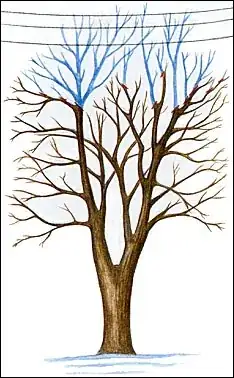Mike Perry is right about NOT sealing wounds with tar or any sealant. This has been the unwavering advice for over 30 years, by tree care researchers such as the Forest Service and university horticulture departments. Look at it this way--you don't seal a human wound, you allow some bleeding to clean it, apply a modern germ killer (the old iodine and mercury solutions killed tissue as well as germs), and then encourage the body's natural regrowth of tissue. The same is true of trees.
When removing branches, cut very near the trunk, but beyond the first 1-2", called the "collar." This is where the healing cover called the "callus" starts to grow. Tree wounds' greatest enemy is fungus diseases. These are more likely to overwhelm the tree in big horizontal cuts, especially during damp weather, which fungi love. As you can see, height reduction, though sometimes necessary, is a long-term risk to the tree's survival. Still, you could drastically shorten and thin this tree, hoping it can cope with that--and plant dwarf or semi-dwarf fruit trees, allowing space to remove the older tree later.
Lichens are free-living, and get their nutrition from algae contained in their fungal walls, NOT from the tree! They grow thickest on older branches that are more open to sunlight—which is what makes it look like they are killing the branch. But they are only taking advantage of its increased sunlight. Some of these grayish lichens are very tasty to deer, which might be why they evolved to grow up in trees, not low down on rocks. They might block some sunlight from ripening fruit, though I haven’t seen or heard of this.
